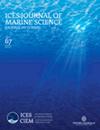热历史揭示了教训鱼(Sepioteuthis lessoniana)的时空分布和种群重叠情况
IF 3.4
2区 农林科学
Q1 FISHERIES
引用次数: 0
摘要
热历史描述了头足类物种从出生到死亡所经历的环境温度,反映了它们的栖息地和分布情况。通过分析2017年至2019年期间从台湾东北部和西南部采集的Sepioteuthis lessoniana成体石像中的本生代氧同位素(δ18O值),重建了热历史。利用空间插值法(普通克里金法)对两个种群中与热历史相关的出现概率进行了建模。东北种群的经历温度(从9.1°C到10.4°C不等)比西南种群的经历温度(从4.3°C到6.8°C不等)表现出更大的个体发育变化。这两个地理种群表现出不同的个体发育运动模式和分布。西南种群受季节性风向的影响,散布范围较广,并倾向于留在澎湖列岛附近的20°C等温线区域成熟和产卵。在季节组群水平上,东北种群在两年的研究期间受厄尔尼诺现象的影响表现出南移的趋势。两个地理种群在成鱼阶段的分布主要在台湾海峡北部重叠,支持台湾种群联系的假设。这项研究揭示了 S. lessoniana 的热历史,为实地观察其分布模式以及将种群动态与环境变化联系起来提供了见解,这对于鱿鱼渔业的可持续管理至关重要。本文章由计算机程序翻译,如有差异,请以英文原文为准。
Thermal histories reveal spatiotemporal distribution and population overlapping of Sepioteuthis lessoniana
Thermal histories describe ambient temperature experienced by cephalopod species from birth to death, reflecting their habitats and distributions. Thermal histories were reconstructed by analyzing ontogenetic oxygen isotopes (δ18O values) in statoliths of adult Sepioteuthis lessoniana collected from northeastern and southwestern Taiwan between 2017 and 2019. The probabilities of occurrence associated with thermal histories in the two populations were modeled using a spatial interpolation approach, ordinary kriging method. The northeastern population exhibited larger ontogenetic variations in experienced temperature (ranging from 9.1 to 10.4°C) than did the southwestern population (ranging from 4.3°C to 6.8°C). The two geographical populations exhibited distinct ontogenetic movement patterns and distribution. The southwestern population demonstrated wide dispersal influenced by seasonal wind directions and tended to remain in 20°C isotherm areas around the Penghu Islands for maturing and spawning. At the seasonal cohort level, the northeastern population exhibited a southward shift during the 2-year study period as a result of the El Niño event. The distribution of the two geographical populations overlapped in the adult stage primarily in the northern Taiwan Strait, supporting an assumption of population connection in Taiwan. This study revealed the thermal histories of S. lessoniana, providing insights into the field observation of distribution patterns and the progress in relating population dynamics to environmental variability, which are essential for the sustainable management of squid fisheries.
求助全文
通过发布文献求助,成功后即可免费获取论文全文。
去求助
来源期刊

ICES Journal of Marine Science
农林科学-海洋学
CiteScore
6.60
自引率
12.10%
发文量
207
审稿时长
6-16 weeks
期刊介绍:
The ICES Journal of Marine Science publishes original articles, opinion essays (“Food for Thought”), visions for the future (“Quo Vadimus”), and critical reviews that contribute to our scientific understanding of marine systems and the impact of human activities on them. The Journal also serves as a foundation for scientific advice across the broad spectrum of management and conservation issues related to the marine environment. Oceanography (e.g. productivity-determining processes), marine habitats, living resources, and related topics constitute the key elements of papers considered for publication. This includes economic, social, and public administration studies to the extent that they are directly related to management of the seas and are of general interest to marine scientists. Integrated studies that bridge gaps between traditional disciplines are particularly welcome.
 求助内容:
求助内容: 应助结果提醒方式:
应助结果提醒方式:


